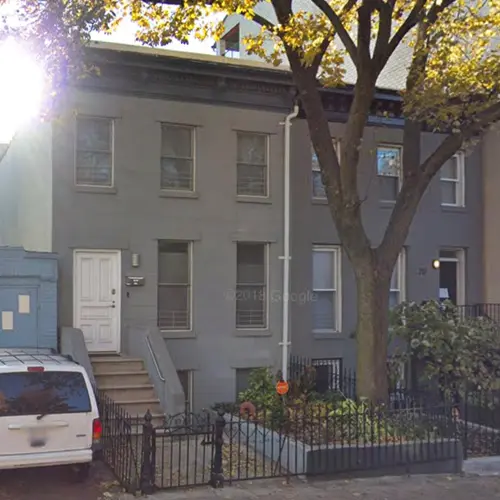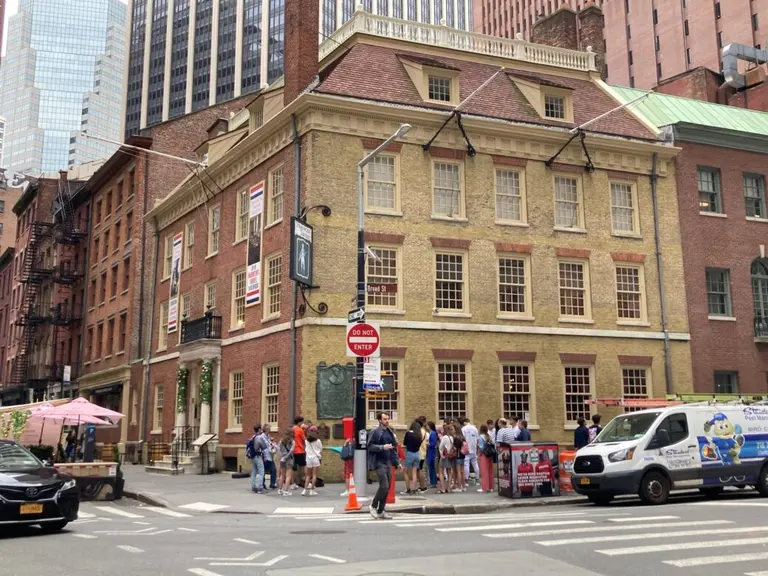Exploring NYC’s historic gay residences beyond Greenwich Village

Clear Comfort, the Alice Austen House, photo by Alice Austen, via NYPL
When most people think about gay New York, they naturally think about all the historic sites located in Greenwich Village and its surrounding vicinity. In fact, the LGBTQ community has long lived and made history citywide from the Bronx to Staten Island. To mark the 2018 NYC Pride Celebration, which will take place from June 14 to 24 with the famed Pride March happening this Sunday, 6sqft has compiled a list of just a few historic gay residences located well beyond Greenwich Village.
1. Mabel Hampton Residence, Claremont Village, The Bronx
 Google Street View of 639 East 169th Street
Google Street View of 639 East 169th Street
Mabel Hampton first took center stage as a singer and dancer during the Harlem Renaissance. By the time of her death, however, she would also be remembered as a pioneering African-American LGBT activist and as one of the founding members of the Lesbian Herstory Archives. Hampton occupied many different apartments during her lifetime. While her early homes were in Harlem, including a now demolished residence at 120 West 122nd Street, in the 1940s, Mabel Hampton moved with her partner, Lillian Foster, to 639 East 169th Street in the Bronx. The residence remains intact.
2. Andy Warhol Residence, Carnegie Hill, Manhattan
 Google Street View of 1342 Lexington Avenue
Google Street View of 1342 Lexington Avenue
Moving further south, but not as far south as one might expect, you’ll arrive at Andy Warhol’s former Upper East Side residence. While one might assume Warhol spent the 1960s to 1970s living, partying and making art downtown, in fact, the iconic artist produced most of his work while living in a townhouse located at 1342 Lexington Avenue in the Carnegie Hill area of the Upper East Side. Warhol lived in the house from 1960 to 1972 and starting in 1974, rented it to his business manager. The artist’s former residence is still standing and most recently sold for just under $9 million dollars.
3. Franklin E. Kameny Childhood Residence, South Richmond Hill, Queens
 L: Tax photo of Kameny’s childhood home in Queens (taken at the time he and his family lived there), c. 1939. Courtesy of the NYC Municipal Archives; R: Google Street View of the house today
L: Tax photo of Kameny’s childhood home in Queens (taken at the time he and his family lived there), c. 1939. Courtesy of the NYC Municipal Archives; R: Google Street View of the house today
Long before LGBTQ rights were an open topic of discussion, Franklin E. Kameny was challenging the public and federal governments to grant equal rights to the gay community. Kameny became an activist out of necessity not choice in 1957 when he was labeled a “sexual prevent” and subsequently fired from the Army Map Service. Rather than retreat, Kameny challenged his dismissal before the Civil Service Commission and eventually sued the government. Despite losing his initial battle, Kameny kept fighting and two years before his death returned to Washington to sign a memorandum guaranteeing benefits to the same-sex partners of federal employees. Kameny’s childhood home is located at 103-17 115th Street in the South Richmond Hill neighborhood of Queens.
4. Walt Whitman House, Clinton Hill, Brooklyn
 99 Ryerson Street, courtesy of the NYC LGBT Historic Sites Project
99 Ryerson Street, courtesy of the NYC LGBT Historic Sites Project
When 19th-century poet Walt Whitman published “Leaves of Grass”—by many considered to be a classic work of American and gay literature—he was living in an unassuming home located at 99 Ryerson Street in the Clinton Hill neighborhood of Brooklyn. The home is well-known but remains largely uncelebrated to this day. In fact, in 2017, the Landmarks Preservation Commission turned down a request to recognize 99 Ryerson Street as a historic site. Despite the fact that Whitman wrote and published “Leaves of Grass” while living in the home, the commission ruled that he didn’t live in the home long enough to merit a designation. They also worried that the home has been renovated so many times over the past century that there is no way to restore it. Despite last year’s rejection, several arts groups continue to call for Whitman’s former home to be designated a historic site.
5. The Lesbian Herstory Archives, Park Slope, Brooklyn
 Google Street View of 484 14th Street
Google Street View of 484 14th Street
The Lesbian Herstory Archives have always been located in a home. In fact, for the first 15 years, the archives were located in the Upper West Side apartment of co-founders Joan Nestle and Deborah Edel at 215 West 92nd Street. As the archive grew, however, it was clear that Nestle and Edel’s kitchen would no longer be an adequate storage site for the growing collection of lesbian materials. After an ambitious fundraising campaign, the Lesbian Herstory Archive Collective managed to persuade a bank to given them a mortgage and they purchased a townhouse in Park Slope at 484 14th Street. Although the archives are no longer located in a private home per se, in keeping with the archives origins, someone still lives in at the address, albeit now occupying a separate apartment on the top floor.
6. Transy House, Park Slope, Brooklyn
 Google Street View of 214 16th Street
Google Street View of 214 16th Street
Just a few blocks away from the Lesbian Herstory Archives is a residence that was long known as Transy House. From 1995 to 2008, Dr. Rusty Mae Moore and Chelsea Goodwin operated Transy House. While first opened up to friends, over a thirteen-year period, their home would welcome friends and strangers alike. Eventually, Moore and Goodwin relocated to Long Island City, where they continue to live with other members of the transgender community. Their Park Slope home, located at 214 16th Street, continues to be remembered and celebrated as a safe haven for the trans community and key site of trans activism in the 1990s to early 2000s.
7. Alice Austen House, Rosebank, Staten Island
 Alice Austen House via Wiki Commons
Alice Austen House via Wiki Commons
While Staten Island is not necessarily New York’s gayest borough, it still has a long and fascinating LGBTQ history. Among its notable attractions is the Alice Austen House at 2 Hylan Boulevard in the Rosebank neighborhood on Staten Island. Austen was born in 1866 and died in 1952. Despite dying nearly two decades before the first NYC Pride event, Austen is remembered as a groundbreaking photographer and important figure in early LGBT American history. While many of her celebrated images simply captured life on Staten Island, Austen is also remembered for her intimate portraits of lesbian life at a time when few such images existed. Notably, despite objections from her family, Alice Austen lived at 2 Hyland Boulevard with her long-time partner, teacher, Gertrude Tate, starting in 1917.
To learn more about historic LGBTQ residences, institutions, and public spaces both in and beyond Greenwich Village, also visit the NYC LGBT Historic Sites Project.
RELATED:


































